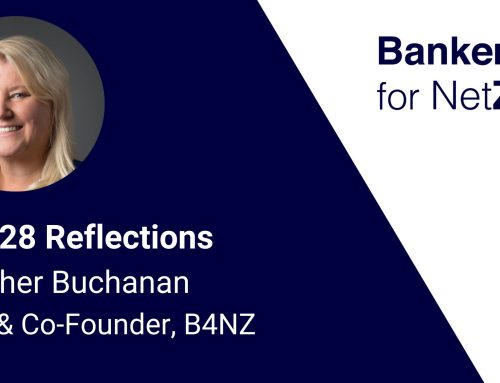Leading from the front
Tide became the first fintech in the world earlier this year to remove 100% of its emissions using durable carbon removals. Now a Net Zero business itself via removals, Tide also committed to reducing its own emissions by 2030 on a revenue basis.
We’re proud to have delivered this milestone, part of a journey that, in truth, began more than two years ago, when we developed a conviction to become a Net Zero business. Key to our success was the need to develop an understanding of how to get there and what shape that would take for the business and our customers (members).
We landed on the Science Based Targets initiative to provide north star guidance to get to Net Zero. With the greenwashing debate hanging over climate change, we looked to the SBTi to underpin Tide’s Net Zero strategy. The SBTI states that to achieve Net Zero, you need to reduce your emissions by at least 90% to 97%, depending on what you choose as your economic basis.
We then worked hard with our Net Zero partners, Supercritical, to lay out the signposts to get to Net Zero, with a third party Carbon Footprint to audit Tide’s carbon emissions.
Durable carbon removals
I’m a firm believer that technology can solve the world’s problems and so we opted for a tech-based solution in the form of durable carbon removals. By definition, removals of this type last for a 100 years or more. Working with our partners, while absorbing what the best minds in the business were saying, we found biochar suited Tide best with its capacity for longevity and potential to scale across markets.
So what is biochar?
Organic material, green waste, is carbonised under high temperatures in the presence of little or no oxygen (a process called pyrolysis) effectively capturing carbon dioxide. The Co2 would otherwise be released into the atmosphere.
The pyrolysis leaves behind a residue called biochar, a magic substance because it both captures the carbon and breaks that cycle removing carbon from the atmosphere. Biochar is also used in agriculture to help provide nutrition to the soil. The knock-on multiple benefits are substantial, including its ability to scale.
Carbon removal market
We at Tide were keen to provide transparency on our purchase of durable carbon removals. We bought 3,711 tonnes of credits, which removed Tide’s 2022 emissions, therefore neutralising our carbon footprint. As an accountant, it resonates with me that we have balanced the books of our carbon emissions which was a pillar in our approach.
With this, we’ve been reporting our carbon emissions to the board.
We also recognised early on that to be truly Net Zero and to ultimately meet the standards of the SBTi, we should not lose sight of longer-term aims to dramatically reduce our own emissions. This forms Pledge 2 of our 3 Net Zero Pledges. As we grow in headcount in our offices in the UK, India and Bulgaria, we will recalculate accordingly.
But for now, no-one else in fintech has yet taken the leap to transform into a 100% Net Zero business via durable carbon removals. We encourage others to consider this path. Don’t just take our word for it, global giants such as Microsoft, Airbus, Amazon, JP Morgan Chase, as well as fintechs Klarna and Stripe have also elected to buy carbon removal credits, many of them biochar.
So, along with becoming a Net Zero business by durable biochar removals (Pledge 1), ensuring we become a Net Zero business by 2030 (Pledge 2), what Tide is also focusing on is Pledge 3: how to facilitate this journey to Net Zero for our members.
Tide’s Net Zero member journey
SMEs emit about 50% of GHG emissions in the UK, so any solution must factor in help to get them to Net Zero. With 550,000 members in the UK and rapid growth in India, Tide has over the years carved out an important place in the SME ecosystem.
SMEs transition to Net Zero
As part of Tide’s Pledge 3, we want to help any SME come to Tide and figure out their own carbon footprint, demystifying the steps to get there and even the huge benefits of trying.
Leaning into helping small businesses figure out their own carbon footprint is step one. That allows them to have the data to be able to know their emissions standpoint, and we can then provide different tools and different ways of thinking around how we might be able to reduce those emissions for SMEs over time.
At the same time, we want to be able to offer our members the tools to be able to purchase removals if they so choose to help them on their Net Zero journey.
We’re currently working on a number of initiatives around a framework of being able to help SMEs understand how to transition to a low-carbon economy. This will allow Tide members access to automated carbon accounting, accounting data for our members; reducing their carbon footprints over time via insights, education and recommendations.
Once again we’re taking the path of technology and data to deliver solutions to reduce climate change, while doing the right thing based on prevailing wisdom of the top minds in this space.
Collaboration
We’ve been working with Bankers for Net Zero to ensure this voice is heard from the member’s perspective. The collaboration has also opened doors to other initiatives such as Perseus, founded by Gavin Starks and IcebreakerOne, of which Tide is a Founding Partner. Our 2023 acquisition of a business called Funding Options, brings into the Tide family another way of helping SMEs source green financing.
Desire for standardisation in the carbon renewal market
When it comes to transparency and accountability in carbon reporting and removal, we’re keen to lead by example.
Many of the discussions we’re having at Tide are around how to make sure we have a single source of truth when it comes to carbon accounting. We don’t want a situation where there is a lack of trust in the data, which would undermine constructive collaboration to reduce climate change.
While the industry has room to grow when it comes to demystifying the measurement and reduction tools available to businesses today, Tide thinks the importance of carbon measurement will simply grow.
We’re already on a journey towards seeing carbon accounting become as integral for business operations as calculating P&L. As an accountant by training, I’m passionate about helping to solve the problem of standardisation and have no doubt that collective action will get us there.
End



